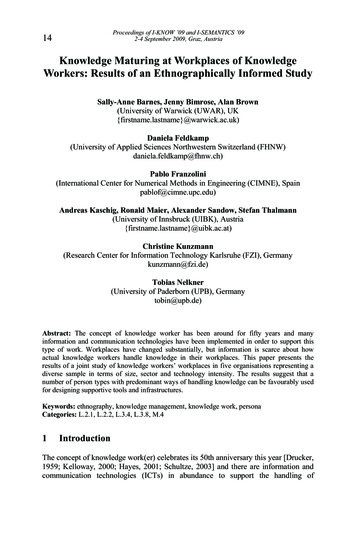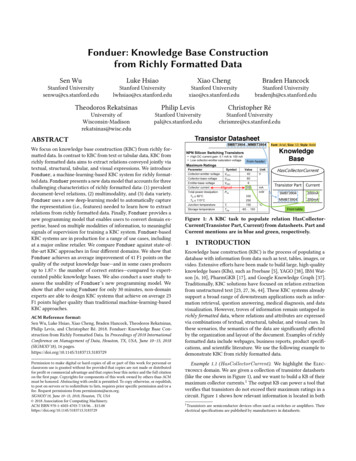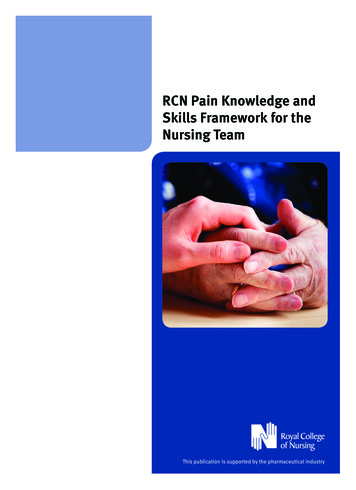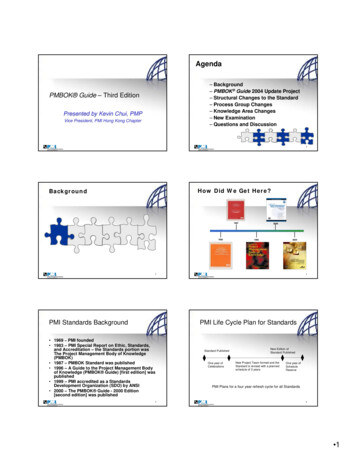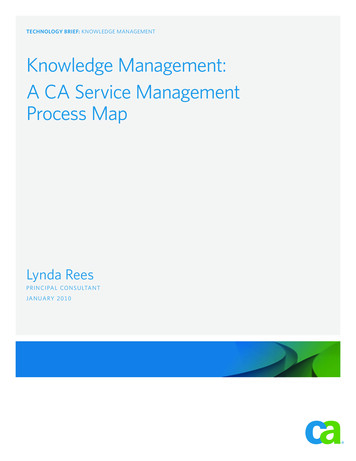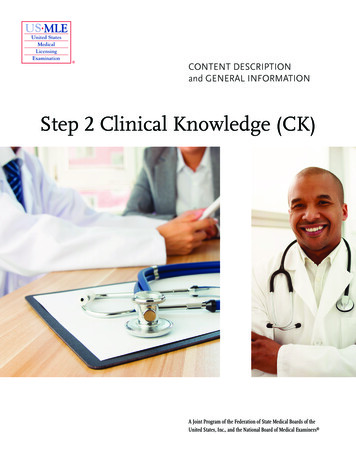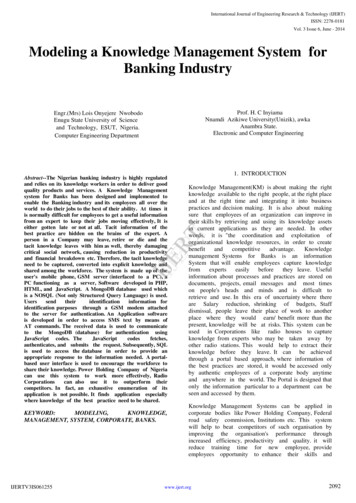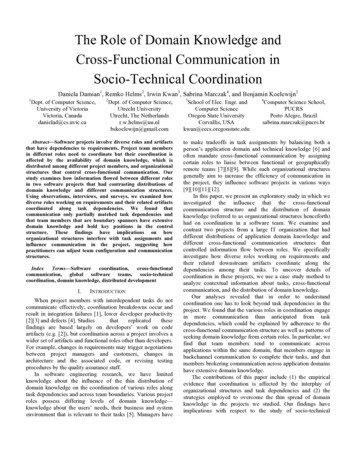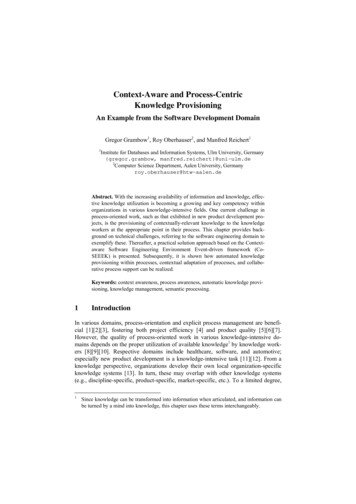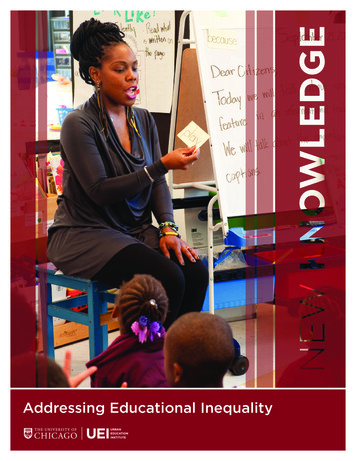
Transcription
Addressing Educational InequalityNEW KNOWLEDGE
Addressing Educational InequalityTHE BIG PICTUREThe debate about whether schools can eradicate gaps in educational achievement between students of differentraces and socioeconomic backgrounds has persisted for decades. On one side of the debate are those whoargue schools cannot possibly eliminate educational inequality before society eradicates economic inequality—that economic and social inequalities outside of schools make closing achievement gaps inside of schools unlikelyat best and impossible at worst. On the other side of the debate are those who point to a significant body ofresearch, which provides strong evidence that schools can, in fact, foster high levels of achievement amongdisadvantaged students by increasing both the quantity and quality of instruction students receive: increasinginstructional time, reducing class size, expanding access to high quality preschool, improving teachers’ knowledgeand skill, and so forth.The paradox is that, despite promising evidence from quite a number of these discrete interventions, the wholehas failed to exceed the sum of its parts; decades of school reform efforts have, on the whole, failed to produceschools that reliably educate disadvantaged students to high levels and achievement gaps persist. In fact, socialclass differences in educational achievement have increased over the past forty years (Reardon 2011).Still, pockets of promise exist. The recently published book, The Ambitious Elementary School, presents evidenceof how a radical reorganization of school structures and rethinking of instructional norms, values, and practiceshas resulted in a significant narrowing of the achievement gap for elementary students on Chicago’s South Side.The books authors, Elizabeth McGhee Hassrick, Stephen W. Raudenbush, and Lisa Rosen, argue that the reasondiscrete school reform efforts have not worked to close achievement gaps is a failure to account for schools asorganizations. They argue that intervening to improve teaching and learning is not like plugging a new applianceinto an electrical outlet. Rather, any new program, technique, curriculum, or practice needs to be purposefullyintegrated within an overall system of instruction that can provide a coherent and coordinated learning experiencefor students. And the authors argue that this, in turn, requires abandoning the traditional, private and autonomousmodel of school organization characterized by privatized instructional practice, significant autonomy for teacherswith very little pedagogical guidance, and a conception of teaching as an idiosyncratic craft rather than a sharedprofessional practice.NEW KNOWLEDGEDrawing on an in-depth study of the University of Chicago Charter School(UChicago Charter) on the South Side of Chicago, Elizabeth McGheeHassrick, Stephen W. Raudenbush, and Lisa Rosen argue that the answerto the question of whether elementary schools can help to ameliorateeducational inequality is yes—but only if they adopt ambitious learninggoals for all children and re-organize teaching and learning to achievethose goals.In their book, The Ambitious Elementary School, they examine a newelementary school model in which a shared and systematic approach toteaching is the norm. The model runs counter to many traditional schoolstructures in which teachers operate autonomously with little interaction,intentional coordination, or guidance. It pulls teachers out of theirisolated classrooms and places them into collaborative environmentswhere they can share their curricula, teaching methods, and assessmentsof student progress with a school-based network of peers, parents, andother professionals. The Ambitious Elementary School describes howthe UChicago Charter School operates and shares the dramatic results ithas produced for children’s reading and math achievement.From 2008 to 2012, the authors interviewed UChicago Charter Schoolfounders, administrators, teachers, and parents while observingclassrooms at two UChicago Charter elementary campuses. TheyNEW KNOWLEDGE
Addressing Educational Inequalitydiscovered that school leadership, teaching and learning, and parental participation followed a remarkablycoherent model that differs substantially from how elementary schools are traditionally organized. Most of TheAmbitious Elementary School is devoted to explaining the conception, design, and implementation of this model.Nearly all of the students at the two campuses the authors studied were African American and 80 percent qualifiedfor reduced-price lunch. Most were admitted to the UChicago Charter School by a random lottery. By tracking438 winners and losers of this lottery on state reading and math tests, the authors were able to obtain unbiasedestimates of the impact of attending the UChicago Charter School over students’ elementary careers and intomiddle school. One key finding was that attending the UChicago Charter School enabled these students to achieve,on average, at a similar level to typical white students in Chicago. A second key finding was that this effectdid not fade out when students left the elementary school and moved on to middle school. By clearly describingthe theory and practice that produced these remarkable gains, the authors aim to challenge ingrained notionsabout school organization, teaching, and learning in elementary schools, and about the potential of schooling toreduce inequality.The Ambitious Elementary School ModelThe UChicago Charter School’s elementary model was built upon three main imperatives: 1) ambitious intellectualwork for every child, 2) organizing teachers’ work to ensure every child is immersed in ambitious intellectual work,and 3) mobilizing broader support for student learning.1) Ambitious Intellectual Work for Every ChildAt the heart of the UChicago Charter elementary model are ambitious learning goals for students. The UChicagoCharter School’s founders believed that school subject matter should be engaging, intellectually challenging, andrelevant to students’ lives, and that teachers should go beyond imparting information to elicit student thinking. Incontrast to many conventional approaches to teaching, which emphasize the absorption of facts and procedures,the UChicago Charter School emphasized the development of “higher-order” abilities such as the capacity tosynthesize and explain complex ideas, interpret and construct arguments, test hypotheses, discover patterns,evaluate claims, and support conclusions with evidence. UChicago Charter teachers functioned as facilitatorsof student learning by creating environments that stimulated processes of knowledge construction and sensemaking in particular subject areas.The UChicago Charter School’s approach to fostering a culture of ambitious intellectual work yielded a sharedand systematic approach to teaching that departed in significant ways from the traditional “egg crate” structureof schools—the cellular organization of classrooms that often keeps individual teachers isolated from one anotherfor much of the day. It laid the groundwork for shared systems of assessment and tailored instruction that servedto close significant student achievement gaps in literacy and math.Adopting a School-Wide Literacy Framework and Math CurriculumHistorically, teachers have worked quite independently in the privacy of their classrooms, without objectiveevidence of their student’s progress. In this setting, an effective teacher is one who can mobilize commitmentand personal knowledge to respond to high levels of uncertainty that arise in day-to-day interactions withheterogeneous students. While some teachers are highly skilled at this, the collective effect of such private,autonomous, and idiosyncratic practice has been largely unexplained variation in teaching effectiveness, leadingto amplified inequality in student outcomes.To foster a shared and systematic approach to meeting ambitious learning objectives—and reduce variability inteachers’ goals, practices, and effectiveness—the UChicago Charter School adopted a research-based, schoolwide literacy framework and math curriculum. This fostered a school-wide commitment to shared and ambitiouslearning goals. It also laid the groundwork for teachers to collaborate and align their instruction around individualstudent needs based on shared materials, practices, and assessments.Frequently Assessing Student Learning and Tailoring Instruction to Students’ SkillsThe UChicago Charter School’s founders believed that teachers often rely too heavily on one-size-fits-allNEW KNOWLEDGE
Addressing Educational Inequalityapproaches to teaching. In contrast, they adopted school-wide approaches to reading and math instruction thatinvolved tailoring instruction to students’ needs based on frequent assessments of students’ learning.In the literacy realm, the UChicago Charter School became an early adopter of a literacy framework and assessmentsystem designed to dynamically guide students through different stages of learning to read, based on theirindividual and continuously evolving skills. One of the hallmarks of UChicago Charter’s literacy framework was“dynamic grouping”—an approach to building rich vocabulary and critical thinking skills that involved frequentlyassessing students’ literacy skills, placing them in small groups based on their individual skill levels, and frequentlyregrouping them based on assessments of their progress through various literacy levels.UChicago Charter leaders adopted a similar approach to reducing inequality and improving students’ achievementin math. They partnered with experts from the University of Chicago’s Center for Elementary Mathematics andScience Education (CEMSE) to implement a school-wide math curriculum designed to foster “mathematical sensemaking”—proficiency in mathematical thinking and problem-solving—as opposed to simply rote memorization ofmathematical calculations and procedures. They used daily, lesson-embedded assessments to gauge students’progress and flexibly arrange them for small group instruction in ways that fostered their individual growth.Expanding Instructional TimeExpanding instructional time and using that time effectively has been critical to the UChicago Charter School’sefforts to foster ambitious instruction and learning in reading, math, and other subject areas. For example,UChicago Charter elementary students received sixty to ninety minutes of math instruction per day compared tothe average of forty-five minutes of daily math instruction a typical U.S. elementary school student received. Thisallowed ample time for teachers to foster a high level of proficiency in mathematical thinking and problem solvingamong students of all skill levels.The UChicago Charter School also aimed to accelerate, reinforce, and augment academic instruction for eachstudent through a deliberate alignment of regular- and extended-day programming. School leaders and teachersworked together to develop a particular portfolio of programs for each student based on their instructional needs.Extended-day staff members overlapped their work shifts between the regular day and extended day, allowingextended-day staff members and regular classroom teachers the opportunity to share information about eachstudent’s daily problems, progress, and needs. Teachers and other regular school day staff trained all extendedday staff in the same academic and behavioral expectations and practices that were in place during the regularschool day. Finally, campus directors ensured that all extended-day partners aligned their programming to supportthe social and academic goals of the school. For example, UChicago Charter used an after-school math curriculumdeveloped by the creators of their regular school-day math curriculum. Many other schools around the nation alsooffered after-school programs, but rarely integrated the activities of their after-school programs with the regularinstruction carried out during the day.2) Organizing Teachers’ Work to Ensure Each Child is Immersedin Ambitious Intellectual WorkProviding Teachers with Ongoing Pedagogical SupportUChicago Charter’s founders aimed to reduce the variation in teaching effectiveness that can contribute toeducational inequality. In contrast to the traditional approach to teacher evaluation that involved school leaders“dropping in on” classrooms a few times per year, the UChicago Charter School made ongoing teacher evaluationthe norm. They also combined ongoing teacher evaluation with ongoing pedagogical support. Rather than offeringsporadic and “one-size-fits-all” professional development opportunities, UChicago Charter leaders providedongoing, tailored pedagogical support based on evidence collected from frequent assessments of studentlearning. UChicago Charter teachers coordinated to develop individual instructional plans for each child—workingclosely with school leaders, social workers, tutors, and extended-day staff over the whole of each child’s schoolcareer—based on frequent assessments of students’ learning.Developing shared practices for fostering student learning and tailoring instruction to students’ individual skill levelsbased on ongoing assessments are ambitious goals that cannot be met without sufficient time for coordinationNEW KNOWLEDGE
Addressing Educational Inequalityand collaboration. In recognition of this, the school’s founders built in 90 minutes of time each day for teachers toengage in collaborative professional learning and planning.Creating Leadership Roles For Expert TeachersExpert teachers played a key role in the provision of ongoing pedagogical support. In contrast to the historicallyflat trajectory of teachers in which promotion and compensation are based on seniority and credentials, theUChicago Charter School created leadership roles for teachers with promotion and compensation based onexpertise in shared instructional systems.Fostering Individual and Collective ResponsibilityIn contrast to the private, autonomous model of schooling in which teachers practiced autonomously with sporadicmonitoring by school leaders, UChicago Charter School directors engaged in ongoing, close analysis of teacherpractice and evidence of student learning. All of the UChicago Charter school’s senior leaders, subject-specificcoaches and teachers, and special education teachers met biweekly to analyze and collectively problem-solvearound student learning data aggregated at the classroom, grade, and school levels. This created increased publicaccountability for student learning, increased scrutiny of teacher practice, and increased expectations on—andsupport for—teachers to develop and share expertise.3) Mobilizing Broader Support for Student LearningContinuously Engaging ParentsThe UChicago Charter School’s founders believed partnerships between parents and teachers mattered—notjust during a crisis or when a student experiences serious learning difficulties, but on a daily, ongoing basis, toensure each child was on track to meet the school’s ambitious learning goals. Consequently, UChicago Charterleaders and teachers made continuous engagement and coordination with parents a central part of their effortsto foster ambitious learning. Each UChicago Charter elementary campus had a director of family and communityengagement devoted to developing strong relationships with students and families, and connecting them withlocal community resources when needed.Teachers also regularly called parents to share updates on students’ progress, and worked to build parents’understanding of the UChicago Charter School’s approach to literacy and math instruction. For example, parentswere trained on how to interpret their students’ progress on the STEP literacy assessment and work with themon reading at home. UChicago Charter also used parent/teacher conferences and “family math nights” to helpparents understand the school’s approach to math education. As parents became conversant in the UChicagoCharter School’s approach, they were encouraged to share their knowledge with other parents who may be newor less familiar with it, providing a network of knowledge to help children grow and achieve. In short, the UChicagoCharter School prioritized and deliberately created roles and structures for continuous parent engagement.Providing Social Supports to Enhance LearningChildren’s social and emotional skills provide a foundation for later success in schooling and beyond. Childrenwho regularly attend school, show up on time, work hard on assignments, meet deadlines, and collaborate wellwith others experience considerable advantages later in life. In recognition of this, the UChicago Charter Schoolmobilized resources to support each student’s individual social and emotional needs. Both leaders and teachersemphasized the importance of knowing their students—understanding both their academic and social-emotionalneeds through a combination of formal and informal structures such as leadership meetings and regular, informalobservation. Each UChicago Charter elementary campus also employed a lead social worker devoted to supportingstudents’ social and emotional development. Lead social workers were core members of the leadership team ateach campus and coordinated with the both the campus director and the family and community engagementdirector to track the social, emotional, and academic development of all students, not just those assigned tospecial education. The ultimate objective was to intervene early and often to prevent small social or emotionalproblems from becoming big problems that may interfere with academic progress and help each student developthe social and emotional skills required to be successful in school and beyond.NEW KNOWLEDGE
Addressing Educational InequalityResults and ImplicationsThe central finding of the book is that students who attended the UChicago Charter School by virtue of winning arandom lottery achieved substantially more in reading and mathematics than those who lost the lottery and wereunable to attend the school. Specifically, children who lost the lottery and therefore were unable to attend theschool scored, on average, at about the 26th percentile of the white distribution in Chicago. That means that 74percent of the white students in Chicago would outscore those children. In contrast, children who won the lotteryand therefore were able to attend the school scored at the 44th percentile of the white distribution. This meansthat only slightly over half of the white students in Chicago would outscore those children. Thus, attending theUChicago Charter School closed most of the gap between these students and white students in Chicago. Thisresult holds up for reading as well as math and is one of the largest effects of innovative schooling in the publishedliterature. Importantly, these results do not fade out but in fact grow as children leave elementary school and moveinto the middle grades.What are the implications of these findings for traditional (non-charter) public schools? The authors do not takea position on the question of school type but rather assert that the UChicago Charter School has lessons to offerfor schools of all types.A great deal can be learned from these schools, and we hope readers will learn from our book. But itdoes not necessarily follow that creating a very large number of charter schools will produce powerfulschooling on a large scale, or that relying on conventional public schools cannot produce such powerfulschooling at scale Networks of charter schools may be powerful equalizers, but so may networks ofoutstanding public schools. What seems to matter most is that adults in the ambitious schoolhousework relentlessly toward the success of every child, and that those adults have access to the knowledge,resources, incentives, and tools that can enable them to realize this commitment.(Hassrick, Raudenbush, and Rosen, The Ambitious Elementary School: Its Conception,Design, and Implications for Educational Equality, 177-178.)For decades, researchers have asked, “Are kids who face challenges economically, in their neighborhoods andsometimes in their homes, capable of achieving at high levels academically?” The Ambitious Elementary Schoolindicates the answer is yes.DEVELOPMENTS TO WATCHAs evidence for more systematic, shared approaches to schooling mounts, we’re beginning to see more schoolsshift from traditional “private and idiosyncratic” approaches to schooling and promote greater collaborationamong school leaders, teachers, social workers, and others who play a pivotal role in students’ education.One emerging approach to reducing educational inequality in a more shared and systematic way involvesintegrating health services into the schoolhouse. Built on the observation that low-quality education and limitedhealthcare access for underserved populations amplify each other and stack up disadvantages, schools followingintegrated health models, such as The Primary School, provide both comprehensive healthcare and schoolingstarting at an early age. Some also incorporate family and community education programs to create a holisticsupport network for the wellness and education of each child.We’ve also seen more schools adopt “blended learning” models designed to catalyze the personalization oflearning and, theoretically, close achievement gaps. The concept of blended learning is highly variable in itsimplementation, but involves engaging students in a mix of supervised, scheduled learning along with self-pacedor personalized learning using digital technology.The body of research on the potential of digital technology to promote educational equality is growing, butquestions and concerns about its usefulness for closing achievement gaps remain. A recent article published inthe Russell Sage Foundation Journal of the Social Sciences posed the question, “Can technology help promoteequality of educational opportunities?”NEW KNOWLEDGE
Addressing Educational InequalityThe authors (Jacob, Berger, Hart, and Loeb) suggest the answer is yes and no. “Advances in artificial intelligencetechnology now allow teachers to differentiate instruction, providing extra support and developmentallyappropriate material to students whose knowledge and skill is far below grade-level norms. The latest ‘intelligent’tutoring systems are able to not only assess a student’s current weaknesses but also diagnose why the studentis making the specific errors (Graesser, Conley, and Olney 2012). Related to this development, the explosion of‘big data,’ in theory, can allow researchers and program developers to utilize the experience of thousands or evenmillions of learners to determine more effective instructional approaches.”However, the authors also note that technological advances such as these aren’t silver bullets for reducingeducational inequality. “Although technologies such as virtual instruction and the suite of programs knowncollectively as intelligent tutoring offer great promise, they are not guaranteed to improve educational equality.Use of these technologies often reduces oversight of students, and that can be particularly detrimental for childrenwho are less motivated or who receive less structured educational supports at home. These technologies mayalso be less effective in engaging reluctant learners in the way a dynamic and charismatic teacher can, suggestingthat even if educational technology improves quality overall, any ‘peak’ education experience it provides may fallshort of a ‘peak’ face-to-face experience. Perhaps more importantly, technologies such as intelligent tutoring andsystems that blend online and face-to-face (FtF) instruction are notoriously difficult to implement well. There isa substantial risk that they could be ineffective or even harmful in places that lack the capacity to implement thetechnologies with fidelity.”Amid all of the experimentation with technology and different approaches to leveling academic playing fields,a consensus seems to converge around the point that more work remains, not only with respect to closing thelongstanding Black-White achievement gap, but also the pervasive gender gap—the gap between male andfemale students’ achievement. The UChicago Charter School and others are beginning to turn their attention toaddressing this gap and others that conspire against an equitable education, and equitable access to economicopportunity, for students of all backgrounds and identities. And they are doing so with more student achievementdata at their disposal than ever before. The question now is whether this data access can translate to strategiesthat work to close achievement gaps. We believe that will require investment in not only data infrastructure, butin good old-fashioned human capital: coaching and professional learning designed to build school leaders’ andteachers’ capacity to apply data to developing actionable strategies for improvement in student outcomes.To download the University of Chicago Urban Education Institute’s full New Knowledge in Public Education Report,visit: https://www.ueiknowledge.org/newknowledgereportNEW KNOWLEDGE
“dynamic grouping”—an approach to building rich vocabulary and critical thinking skills that involved frequently assessing students’ literacy skills, placing them in small groups based on their individual skill levels, and frequently . the school’s founders built in 90 minutes of time each
